 W
WAtsumari is a binary-determination puzzle that was originally developed by Quadratic Games for the iPhone platform. The puzzle is played on a hexagonal grid. A rectangular board shape is standard but variations to the board shape can be part of the puzzle design. The puzzle starts with a subset of the hexagonal cells containing a number greater than or equal to zero. The solution to the puzzle is a unique pattern of black/white hexagonal cells that does not violate any of the puzzle rules.
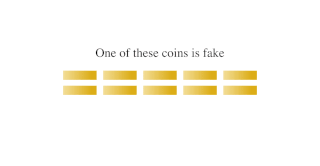 W
WA balance puzzle or weighing puzzle is a logic puzzle about balancing items—often coins—to determine which holds a different value, by using balance scales a limited number of times. These differ from puzzles that assign weights to items, in that only the relative mass of these items is relevant.
 W
WThe Battleship puzzle is a logic puzzle based on the Battleship guessing game. It and its variants have appeared in several puzzle contests, including the World Puzzle Championship, and puzzle magazines, such as Games magazine.
 W
WBulls and Cows is an old code-breaking mind or paper and pencil game for two or more players, predating the commercially marketed board game Mastermind.
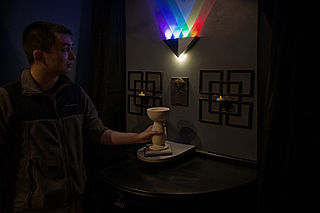 W
WAn escape room, also known as an escape game, is a game in which a team of players cooperatively discover clues, solve puzzles, and accomplish tasks in one or more rooms in order to progress and accomplish a specific goal in a limited amount of time. The goal is often to escape from the site of the game.
 W
WFill-Ins, also known as Fill-It-Ins or Word Fills, are a variation of the common crossword puzzle in which words, rather than clues, are given. Fill-Ins are common in puzzle magazines along with word searches, cryptograms, and other logic puzzles. Some consider Fill-Ins to be an easier version of the crossword. Since the Fill-In requires no outside knowledge of specific subjects, one can solve the puzzle in another language.
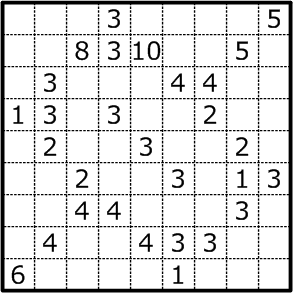 W
WFillomino (フィルオミノ) is a type of logic puzzle published by many publishers. Other published titles for the puzzle include Allied Occupation.
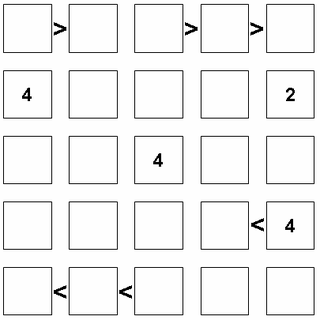 W
WFutoshiki , or More or Less, is a logic puzzle game from Japan. Its name means "inequality". It is also spelled hutosiki. Futoshiki was developed by Tamaki Seto in 2001.
 W
WThe Gear Cube is a 3-D combination puzzle designed and created by Dutch puzzle maker Oskar van Deventer based on an idea by Bram Cohen. It was initially produced by Shapeways in 2009 and known as "Caution Cube" due to the likeliness of getting fingers stuck between the gears while speedcubing. Later, in 2010, it was mass-produced by Meffert's as the "Gear Cube".
 W
WGokigen Naname is a binary-determination logic puzzle published by Nikoli.
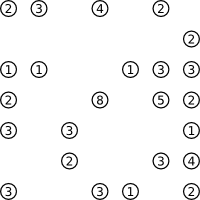 W
WHashiwokakero is a type of logic puzzle published by Nikoli. It has also been published in English under the name Bridges or Chopsticks. It has also appeared in The Times under the name Hashi. In France, Denmark, the Netherlands, and Belgium it is published under the name Ai-Ki-Ai.
 W
WThe Helicopter Cube is a Rubik's Cube-like puzzle invented by Adam G. Cowan in 2005 and built in 2006. It is also in the shape of a cube. At first glance, the Helicopter Cube may seem like a combination of the 2x2x2 and the Skewb, but it actually cuts differently, and twists around cube edges rather than cube faces. The purpose of the puzzle is to scramble the colors, and then restore them back to their original state of a single color per face.
 W
WHeyawake is a binary-determination logic puzzle published by Nikoli. As of 2013, five books consisting entirely of Heyawake puzzles have been published by Nikoli. It first appeared in Puzzle Communication Nikoli #39.
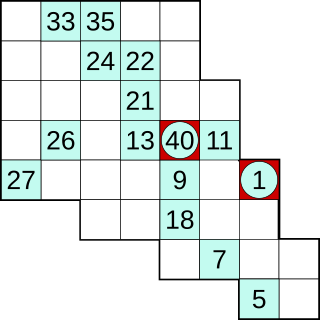 W
WHidato, also known as "Hidoku", is a logic puzzle game invented by Dr. Gyora M. Benedek, an Israeli mathematician. The goal of Hidato is to fill the grid with consecutive numbers that connect horizontally, vertically, or diagonally. The name Hidato is a registered trademark of Doo-Bee Toys and Games LTD, a company co-founded by Benebek himself. Some publishers use different names for this puzzle such as Number Snake, Snakepit, Jadium or Numbrix.
 W
WHitori is a type of logic puzzle published by Nikoli.
 W
WHooper's paradox is a falsidical paradox based on a optical illusion. A geometric shape with an area of 32 units is dissected into four parts, which afterwards get assembled into a rectangle with an area of only 30 units.
 W
WInshi no heya is a type of logic puzzle published by Nikoli. It is a specific form of the KenKen puzzle genre where every operation is implied to be multiplication.
 W
WKakuro or Kakkuro or Kakoro is a kind of logic puzzle that is often referred to as a mathematical transliteration of the crossword. Kakuro puzzles are regular features in many math-and-logic puzzle publications across the world. In 1966, Canadian Jacob E. Funk, an employee of Dell Magazines, came up with the original English name Cross Sums and other names such as Cross Addition have also been used, but the Japanese name Kakuro, abbreviation of Japanese kasan kurosu, seems to have gained general acceptance and the puzzles appear to be titled this way now in most publications. The popularity of Kakuro in Japan is immense, second only to Sudoku among Nikoli's famed logic-puzzle offerings.
 W
WKuromasu is a binary-determination logic puzzle published by Nikoli. As of 2005, one book consisting entirely of Kuromasu puzzles has been published by Nikoli.
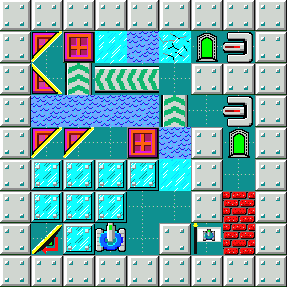 W
WLaserTank is a computer puzzle game requiring logical thinking to solve a variety of levels. It is open source, careware, and can be used for free. The player must be able to concentrate and think ahead as in playing chess or checkers. Contradicting its name, LaserTank is in no way an action game. Although a player may try to solve a level quickly, there is no requirement to do so, so poor coordination and poor reflexes will not impede a player. Experience allows the player to learn a number of techniques and tricks that need to be used to solve difficult levels. LaserTank is NP-complete meaning that one can construct levels which are hard to solve for even computers.
Light Up, also called Akari, is a binary-determination logic puzzle published by Nikoli. As of 2011, three books consisting entirely of Light Up puzzles have been published by Nikoli.
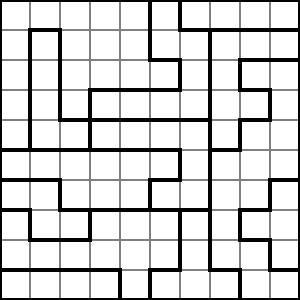 W
WLITS, formerly known as Nuruomino (ヌルオミノ), is a binary determination puzzle published by Nikoli.
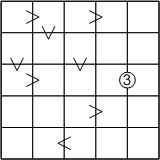 W
WMainarizumu (マイナリズム) is a type of logic puzzle published by Nikoli.
 W
WMastermind or Master Mind is a code-breaking game for two players. The modern game with pegs was invented in 1970 by Mordecai Meirowitz, an Israeli postmaster and telecommunications expert. It resembles an earlier pencil and paper game called Bulls and Cows that may date back a century.
 W
WMasyu is a type of logic puzzle designed and published by Nikoli. The purpose of its creation was to present a puzzle that uses no numbers or letters and yet retains depth and aesthetics.
 W
WThe missing square puzzle is an optical illusion used in mathematics classes to help students reason about geometrical figures; or rather to teach them not to reason using figures, but to use only textual descriptions and the axioms of geometry. It depicts two arrangements made of similar shapes in slightly different configurations. Each apparently forms a 13×5 right-angled triangle, but one has a 1×1 hole in it.
 W
WThe monkey and banana problems is a famous toy problem in artificial intelligence, particularly in logic programming and planning.
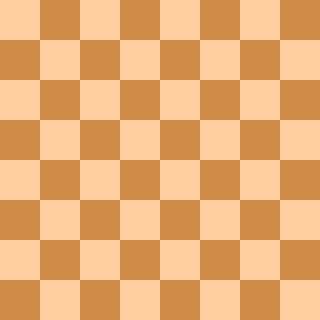 W
WThe mutilated chessboard problem is a tiling puzzle proposed by philosopher Max Black in his book Critical Thinking (1946). It was later discussed by Solomon W. Golomb (1954), Gamow & Stern (1958) and by Martin Gardner in his Scientific American column "Mathematical Games". The problem is as follows:Suppose a standard 8×8 chessboard has two diagonally opposite corners removed, leaving 62 squares. Is it possible to place 31 dominoes of size 2×1 so as to cover all of these squares?
 W
WNonograms, also known as Paint by Numbers, Picross, Griddlers, Pic-a-Pix, and various other names, are picture logic puzzles in which cells in a grid must be colored or left blank according to numbers at the side of the grid to reveal a hidden picture. In this puzzle type, the numbers are a form of discrete tomography that measures how many unbroken lines of filled-in squares there are in any given row or column. For example, a clue of "4 8 3" would mean there are sets of four, eight, and three filled squares, in that order, with at least one blank square between successive sets.
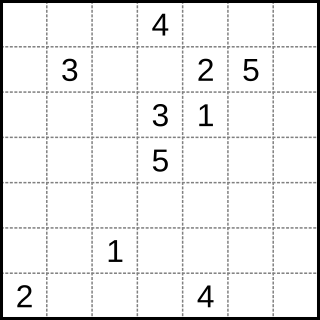 W
WNumberlink is a type of logic puzzle involving finding paths to connect numbers in a grid.
 W
WNurikabe is a binary determination puzzle named for Nurikabe, an invisible wall in Japanese folklore that blocks roads and delays foot travel. Nurikabe was apparently invented and named by Nikoli; other names for the puzzle include Cell Structure and Islands in the Stream.
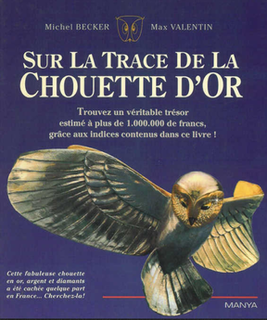 W
WOn The Trail Of The Golden Owl is a French armchair treasure hunt book created by communications expert Régis Hauser under the pseudonym "Max Valentin" and illustrated by artist Michel Becker. The book was first published in 1993. It provides clues to the location of a buried statuette of an owl, created by Becker.
 W
WPetals Around the Rose is a mathematical challenging puzzle in which the object is to work out the formula by which a number is derived from the roll of a set of five or six dice. It is often used as an exercise in inductive reasoning. The puzzle became popular in computer circles in the mid 1970s, particularly through an anecdote recounted in Personal Computing which depicts Bill Gates working out the solution in an airport.
 W
WRipple Effect is a logic puzzle published by Nikoli. As of 2007, two books consisting entirely of Ripple Effect puzzles have been published by Nikoli. The second was published on October 4, 2007.
 W
WA river crossing puzzle is a type of puzzle in which the object is to carry items from one river bank to another, usually in the fewest trips. The difficulty of the puzzle may arise from restrictions on which or how many items can be transported at the same time, or which or how many items may be safely left together. The setting may vary cosmetically, for example, by replacing the river by a bridge. The earliest known river-crossing problems occur in the manuscript Propositiones ad Acuendos Juvenes, traditionally said to be written by Alcuin. The earliest copies of this manuscript date from the 9th century; it contains three river-crossing problems, including the fox, goose and bag of beans puzzle and the jealous husbands problem.
 W
WThe Rubik's Cube is a 3-D combination puzzle invented in 1974 by Hungarian sculptor and professor of architecture Ernő Rubik. Originally called the Magic Cube, the puzzle was licensed by Rubik to be sold by Ideal Toy Corp. in 1980 via businessman Tibor Laczi and Seven Towns founder Tom Kremer. Rubik's Cube won the 1980 German Game of the Year special award for Best Puzzle. As of January 2009, 350 million cubes had been sold worldwide, making it the world's top-selling puzzle game. It is widely considered to be the world's best-selling toy.
 W
WShakashaka (シャカシャカ) is a logic puzzle developed by publisher Nikoli. The objective is to fill the white squares in a given grid with a pattern of triangles such that each white area in the resulting grid has a rectangular shape. Furthermore, each black square in the grid marked with a number must be orthogonally adjacent to the specified number of triangles.
 W
WShinro (しんろ) is a logic-based puzzle that has similarities to Sudoku and Minesweeper. The objective is to locate 12 hidden 'Holes' on an 8×8 grid. The board contains a variable number of arrows, each of which points to at least one Hole. A count of the number of Holes is given for each Row and Column.
 W
WThe Skewb is a combination puzzle and a mechanical puzzle in the style of Rubik's Cube. It was invented by Tony Durham and marketed by Uwe Mèffert. Although it is cubical in shape, it differs from Rubik's construction in that its axes of rotation pass through the corners of the cube rather than the centres of the faces. There are ten such axes, one for each space diagonal of the cube. As a result, it is a deep-cut puzzle in which each twist affects all three faces.
 W
WSlitherlink is a logic puzzle developed by publisher Nikoli.
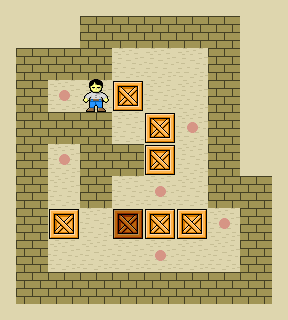 W
WSokoban is a puzzle video game genre in which the player pushes crates or boxes around in a warehouse, trying to get them to storage locations.
 W
WThe Square-1, also known as Back to Square One and Cube 21, is a puzzle similar to the Rubik's Cube. Its distinguishing feature among the numerous Rubik's Cube variants is that it can change shape as it is twisted, due to the way it is cut, thus adding an extra level of challenge and difficulty. The Super Square One and Square Two puzzles have also been introduced. The Super Square One has two additional layers that can be scrambled and solved independently of the rest of the puzzle, and the Square Two has extra cuts made to the top and bottom layer, making the edge and corner wedges the same size.
 W
WStained Glass is a binary determination logic puzzle published by Nikoli.
 W
WStr8ts is a logic-based number-placement puzzle, invented by Jeff Widderich in 2008. It is distinct from, but shares some properties and rules with Sudoku. The name is derived from the poker straight. The puzzle is published in a number of newspapers internationally, in two book collections, and in downloadable apps. It was featured on the Canadian television show Dragons' Den on November 24, 2010.
 W
WSudoku is a logic-based, combinatorial number-placement puzzle. In classic sudoku, the objective is to fill a 9×9 grid with digits so that each column, each row, and each of the nine 3×3 subgrids that compose the grid contain all of the digits from 1 to 9. The puzzle setter provides a partially completed grid, which for a well-posed puzzle has a single solution.
 W
WSujiko is a logic-based, combinatorial number-placement puzzle created by Jai Gomer of Kobayaashi Studios.
 W
WSuper Swap is an action puzzle game developed by Teyon for the Nintendo DSiWare. It is available in the Nintendo DSi Shop for 500 Nintendo DSi Points.
 W
WTantrix is a hexagonal tile-based abstract game invented by Mike McManaway from New Zealand. Each of the 56 different tiles in the set contains three lines, going from one edge of the tile to another. No two lines on a tile have the same colour. There are four colours in the set: red, yellow, blue, and green. No two tiles are identical, and each is individually numbered from 1 through 56.
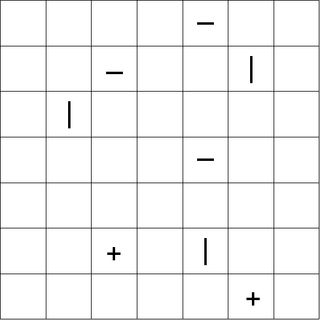 W
WTatamibari is a type of logic puzzle designed and published by Nikoli. The puzzle is based on Japanese tatami mats.
 W
WTheseus and the Minotaur is a type of logic maze designed by Robert Abbott. In this maze, the player acts as Theseus, the king of Athens who is attempting to escape the Labyrinth. The main difference between this and the standard type of labyrinth, beyond the fact that it is set on a grid, is the fact that the maze is not empty, but also contains a Minotaur who hunts the player down, taking two steps for every one the player takes.
 W
WThe Wason selection task is a logic puzzle devised by Peter Cathcart Wason in 1966. It is one of the most famous tasks in the study of deductive reasoning. An example of the puzzle is:You are shown a set of four cards placed on a table, each of which has a number on one side and a colored patch on the other side. The visible faces of the cards show 3, 8, red and brown. Which card(s) must you turn over in order to test the truth of the proposition that if a card shows an even number on one face, then its opposite face is red?
 W
WWater pouring puzzles are a class of puzzle involving a finite collection of water jugs of known integer capacities . Initially each jug contains a known integer volume of liquid, not necessarily equal to its capacity. Puzzles of this type ask how many steps of pouring water from one jug to another are needed to reach a goal state, specified in terms of the volume of liquid that must be present in some jug or jugs.
 W
WYajilin (ヤジリン) is a type of logic puzzle published by Nikoli. It has been published in English under the name Arrow Ring, such as in the 2005 U.S. qualifier for the World Puzzle Championship.